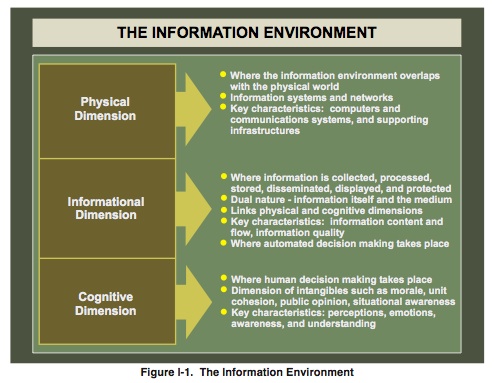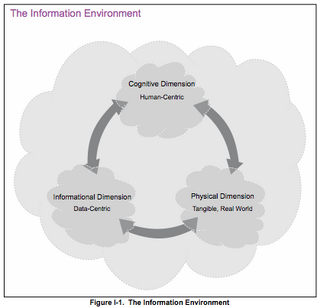Definition
Military
The information environment is
| “ | the aggregate of individuals, organizations, and systems that collect, process, disseminate, or act on information.[1] | ” |
Overview
The actors include leaders, decision makers, individuals, and organizations. Resources include the materials and systems employed to collect, analyze, apply, or disseminate information. The information environment is where humans and automated systems observe, orient, decide, and act upon information, and is therefore the principal environment of decision making. Even though the information environment is considered distinct, it resides within each of the four domains.
Dimensions
The information environment is made up of three interrelated dimensions: physical, informational, and cognitive.
- The Physical Dimension. The physical dimension is composed of the command and control (C2) systems, and supporting infrastructures that enable individuals and organizations to conduct operations across the air, land, sea, and space domains. It is also the dimension where physical platforms and the communications networks that connect them reside. The physical dimension includes, but is not limited to, human beings, C2 facilities, newspapers, books, microwave towers, computer processing units, laptops, smart phones, tablet computers, or any other objects that are subject to empirical measurement. The physical dimension is not confined solely to military or even nation-based systems and processes; it is a defused network connected across national, economic, and geographical boundaries.
- The Informational Dimension. The informational dimension is where information is collected, processed, stored, disseminated displayed, and protected. It is the dimension where the C2 of military forces is exercised and where the commander's intent is conveyed. Actions in this dimension affect the content and flow of information.
- The Cognitive Dimension. The cognitive dimension encompasses the mind of the decision maker and the target audience (TA). This is the dimension in which people think, perceive, visualize, and decide. It refers to individuals' or groups' information processing, perception, judgment, and decision making. These elements are influenced by many factors, to include individual and cultural beliefs, norms, vulnerabilities, motivations, emotions, experiences, morals, education, mental health, identities, and ideologies. Defining these influencing factors in a given environment is critical for understanding how to best influence the mind of the decision maker and create the desired effects. As such, this dimension constitutes the most important component of the information environment.
Properties
- Physical Properties. Physical properties of the information environment include people, places, things, and capabilities of information infrastructure and adversary information capabilities.
- Informational Properties. Informational properties of the information environment include those systems and networks where information is created, processed, manipulated, transmitted, and shared. It includes those properties relevant to the electronic collection, transmission, processing, storage, and display of information. These properties may be electronic or human-to-human or a combination of both. They describe the formal and informal communications infrastructure and networks, kinship and descent relationships, licit and illicit commercial relationships and social affiliations and contacts that collectively create, process, manipulate, transmit, and share information in an operational area and among TAs. Examples of informational properties include:
- (a) Specification, capacity, configuration, and usage of information infrastructure and capabilities.
- (b) Technical design of information infrastructure.
- (c) Networks of human-to-human contact used for the transmission of information
- (d) Social and commercial networks that process and share information and influence (kinship and descent linkages, formal and informal social contacts, licit and illicit commercial affiliations and records of ownership and transactions, etc.).
- (e) Content and context.
- Cognitive Properties. Cognitive properties of the information environment are the psychological, cultural, behavioral, and other human attributes that influence decision making, the flow of information, and the interpretation of information by individuals or groups at any level in a state or organization.
References
- ↑ U.S. Department of Defense, Joint Pub. 1–02: DOD Dictionary of Military and Associated Terms (Nov. 8, 2010, as amended through May 15, 2011) (full-text).
Sources
- Joint Publication 3-13, at I-2 and I-3.
- U.S. Joint Chiefs of Staff, "Joint Publication 3-13," at I-1, III-2 (Feb. 13, 2006) (full-text).

